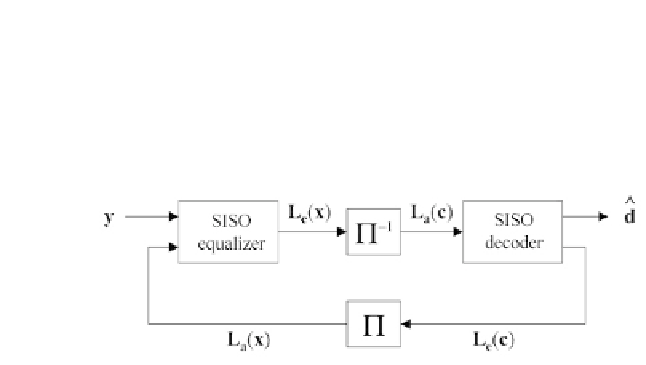Cryptography Reference
In-Depth Information
possible the probabilistic data exchanged between the equalizer and the
channel decoder. The turbo equalizer is then capable of totally compensat-
ing the degradation caused by the ISI, with the reserve that the interleaver
be large enough and carefully constructed.
Figure 11.9 - Turbo equalizer for BICM transmission systems.
Generally, the turbo equalizer corresponding to the transmission scenario
in Figure 11.8 takes the form shown in Figure 11.9. It is first made up of a
SISO equalizer, which at the input takes both vector
y
of the data observed
at the output of the channel, and
a priori
probabilistic information on the
set of coded, interleaved bits
x
i,j
, here formally denoted
L
a
(
x
)=
.
The probabilistic information is propagated in the form of log likelihood ratios
(LLRs), the definition of which we recall here for a binary random variable
d
with values in
{
L
a
(
x
i,j
)
}
{
0
,
1
}
:
L
(
d
)=ln
Pr(
d
=1)
Pr(
d
=0)
(11.4)
The notion of LLR provides twofold information since the sign of the quantity
L
(
d
)
gives the hard decision on
d
, while its absolute value
|
L
(
d
)
|
measures the
reliability this decision can be given.
From the two pieces of information
y
and
L
a
(
x
)
, the SISO equalizer produces
extrinsic information denoted
L
e
(
x
)=
on the coded, interleaved bi-
nary message. This vector
L
e
(
x
)
is then deinterleaved to give a new sequence
L
a
(
c
)
,whichisthe
a priori
information on the sequence coded for the SISO
decoder. The latter then deduces two pieces of information from this: a hard
decision on the information message transmitted, here denoted
d
, and some new
extrinsic information on the coded message, denoted
L
e
(
c
)
. This information is
then re-interleaved and sent back to the SISO equalizer where it is exploited as
a priori
information for a new equalization step at the following iteration.
The turbo equalization scheme that we have presented above corresponds to
BICM transmitters. It is however important to note that the turbo equalization
principle also applies in the case of a system implementing traditional coded
modulation, that is to say, a system where the coding and modulation operations
are jointly optimized, on condition however that the symbols to be transmitted
are interleaved before being modulated and sent on the channel (Figure 11.10).
{
L
e
(
x
i,j
)
}




